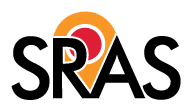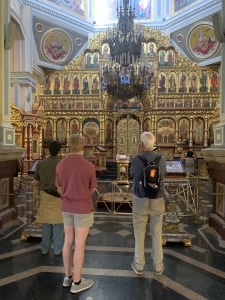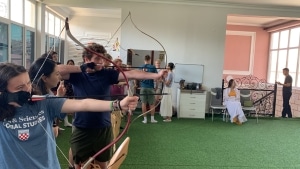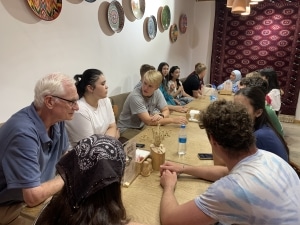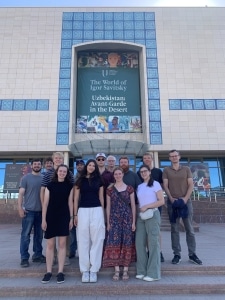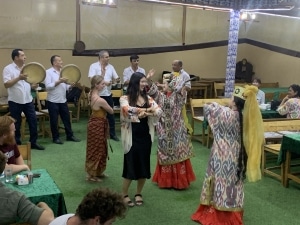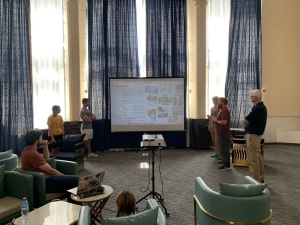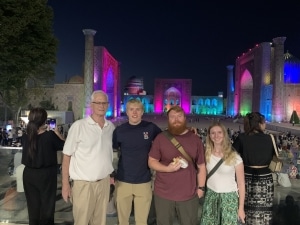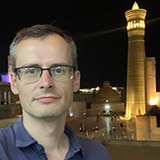This past July, I had the privilege of leading a group of twelve American college students through Kazakhstan and Uzbekistan on the pilot run of a newly created SRAS program, the RSL+ Travel Adventure. As the coordinator of this program, I had watched these students spend eight intensive weeks in Bishkek, Kyrgyzstan, studying Russian. By the time we set off for our two-week journey through Almaty and several Uzbek cities, they were ready to put their language skills to the test in new contexts.
To prepare them, I held weekly meetings while they were still in Bishkek. In those sessions, we worked through readings and short videos about the places they would visit, learned key vocabulary, and reviewed it with short quizzes to ensure retention. These meetings gave the students a solid foundation and helped them adapt more smoothly to the experiences that awaited them.
The goal of the trip was simple but ambitious: immerse them in Russian-speaking environments beyond Kyrgyzstan, using Russian as the region’s lingua franca. To keep the focus, we made a Russian-only pledge—students communicated in Russian with me, with guides, and with locals at every step. Our guides in both countries, Gulmira in Kazakhstan and Mansur in Uzbekistan, spoke only Russian to the students, as did the drivers, hotel staff, and waiters we encountered along the way. This consistency created an authentic environment where students had no choice but to use their Russian constantly—and their confidence grew as a result.
Almaty: First Impressions of Kazakhstan
Our journey out of Kyrgyzstan began with a 30-minute drive from Bishkek to the Kazakh border where we were welcomed by our wonderful guide Gulmira. Our first stop was the Tamgaly-Tas Petroglyphs, a striking site of ancient rock carvings that show just how far back civilization in this area stretches. From there, we drove to Almaty, where the group enjoyed a hearty dinner of Kazakh national dishes at Paradise Café, joined by local friends and our guides. The table was full of lively conversation in Russian as students sampled delicious kuurdak and drank refreshing kompot, while Madiyor, our local friend who coincidentally had studied gastronomy at Boston University, shared some interesting insights about the dishes.
The following days were packed with exploration. Students toured the Central State Museum, walked through the Park of 28 Panfilov Guardsmen, visited the Ascension Cathedral, and rode up to Shymbulak and Kok Tobe for sweeping views of the mountains and the city at sunset. A highlight came when our students met with local peers for an archery workshop and lunch. Conversations flowed naturally in Russian, and the excitement of cross-cultural exchange made the language practice feel effortless. It was the kind of experience that can’t be replicated in a classroom—full of laughter, friendly competition, and genuine connection.
Uzbekistan: From Nukus to Tashkent
From Almaty, we flew south to Uzbekistan, where our guide there, Mansur, immediately won the group over with his clarity, humor, and constant engagement. In Nukus, students were introduced to the world-famous Savitsky Museum, home to avant-garde Soviet art, before we continued on to Khiva. Walking through Khiva’s illuminated old city at night felt like stepping into another era—narrow alleys, glowing minarets, and the sounds of evening life all around.
In Bukhara, our students explored the Poi Kalyan complex and Lyabi Hauz, and participated in a scavenger hunt designed by local students. The activity challenged them to use Russian in creative and practical ways—asking for directions, bargaining in markets, and gathering information to complete their tasks. From there, we took the train to Samarkand, where the grandeur of Registan Square left a deep impression. Finally, we arrived in Tashkent, a city that offered a refreshing contrast with its wide avenues, modern buildings, authentic Soviet subway, and, of course, the unforgettable plov at the famed Besh Qazan.
Learning in Action
Beyond sightseeing, the trip was structured around daily assignments that kept students actively using Russian. Each day, they sent me short voice diaries reflecting on their experiences, along with new vocabulary they had picked up in context. By the end of the trip, every student had also interviewed a local in Russian, capturing authentic perspectives from the people they met. These interviews were often some of the most rewarding moments, as students realized they could not only sustain but fully lead meaningful conversations entirely in Russian.
For their final project, students worked in teams to create Russian-language travel guides aimed at helping future groups of American students. They presented these guides in our hotel conference room in Tashkent—covering everything from must-see sights and food recommendations to practical tips and cultural do’s and don’ts. Even though they had little time to prepare, the presentations were thoughtful, engaging, and a clear demonstration of how much progress they had made.
Reflections
The journey was not without challenges: the summer heat was relentless, and long travel days were tiring. Yet the rewards far outweighed the discomforts. Students stayed committed to the Russian-only rule, and their progress over the two weeks was noticeable. More importantly, they gained confidence speaking Russian in real-world contexts—ordering meals, chatting with guides, navigating new cities, and connecting with their peers from Kazakhstan and Uzbekistan.
As we shared a farewell dinner at Caravan, a traditional restaurant in Tashkent, I felt proud watching how far the students had come since their first hesitant days in Bishkek. The trip was more than a tour of Central Asia—it was a living classroom that combined history, culture, language, and personal growth in unforgettable ways. We look forward to welcoming our next cohort of student next summer for RSL+ Travel Adventure!
